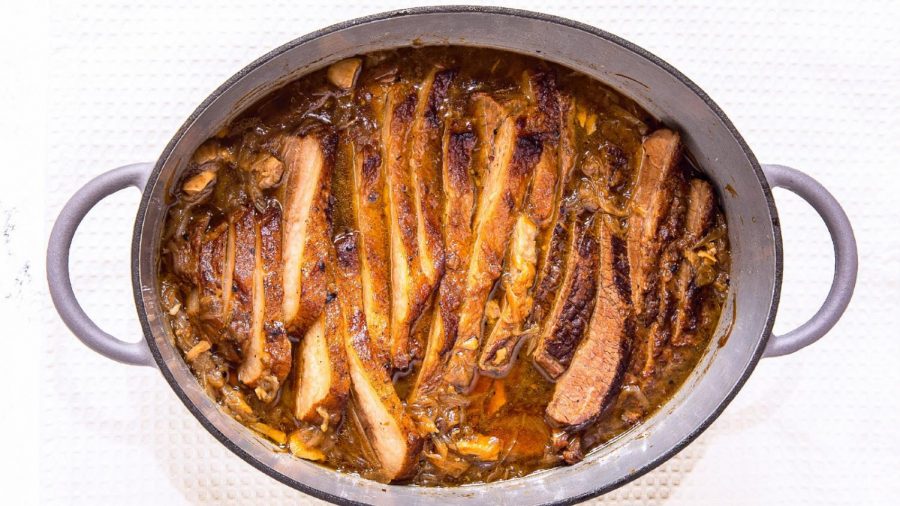This French Onion Brisket recipe honors both tradition and innovation
Published March 9, 2021
(The Nosher via JTA) – Brisket is political. You may think of it as a cozy braise, but it’s so much more. It’s a vessel of family pride and tradition. A consistent comfort food made for any celebratory occasion. Gentiles may have family crests, but Jews have family brisket recipes. Everything I know about brisket I learned from my aunt Susi. Growing up, she would host the High Holidays in her apartment, where an extremely worn Le Creuset Dutch oven filled with brisket bubbling in tomato sauce sat on her crowded stovetop. Silver platters were passed around, perfuming the room with the aromas of bay leaves and garlic, as everyone showered Susi with compliments.
Testing and adapting recipes from chefs and food writers far and near, I’ve seen the full spectrum of briskets, from those laced with dried porcini for an ultra-savory punch to three-ingredient versions that only use onions and a giant bottle of ketchup (both are equally lovely).
This recipe is my way of taking poetic license with brisket, drawing inspiration from French onion soup for a braising liquid of caramelized onions and garlic, deglazed with apple brandy.
ADVERTISEMENT
I’ve now taken over for Susi in preparing the brisket for the holidays, which has come with its own set of expectations. Well, actually, there’s only one responsibility no matter which recipe you follow: make enough for leftovers.
Excerpted from JEW-ISH: A COOKBOOK: Reinvented Recipes from a Modern Mensch© 2021 by Jake Cohen. Photography © 2021 by Matt Taylor-Gross. Reproduced by permission of Houghton Mifflin Harcourt. All rights reserved.
Ingredients
- 1 (5-to 6-pound) beef brisket, fat cap intact
- kosher salt and freshly ground black pepper
- 3 Tbsp vegetable oil
- 5 large sweet onions, thinly sliced
- 12 garlic cloves, smashed and peeled
- 1 cup Calvados or sherry
- 3 cups chicken stock
- 6 sprigs thyme
- 4 sprigs sage
Directions
- Preheat the oven to 325 degrees F.
- Season each side of the brisket with 2 heavy pinches each of salt and pepper. In a large Dutch oven, heat the oil over medium-high heat. Sear the brisket, turning it as needed, until golden brown, 15 to 20 minutes. Transfer the brisket to a platter.
- Reduce the heat to medium, then add the onions and garlic to the pot. Cook, stirring often, until softened and caramelized, 20 to 25 minutes. Add the Calvados, then stir continuously with a wooden spoon for 1 minute to scrape up any browned bits on the bottom of the pot.
- Stir in the stock and 2 heavy pinches each of salt and pepper, then return the brisket to pot. Tie together the thyme and sage sprigs with a small piece of butcher’s twine (tying is optional,but makes it much easier to remove the herbs after cooking) and nestle the herb bundle in the pot. Bring to a simmer, then cover the pot and transfer it to the oven. Cook for 3 hours to 3 hours 30 minutes, until very tender when pierced with a fork. Remove from the oven and let cool completely, then refrigerate overnight.
- The next day, skim off and discard any fat, if desired, and discard the herbs.Transfer the brisket to a cutting board and cut it across the grain (perpendicular to the fibers you’ll see running through the brisket) into 1⁄4-inch-thick slices. Return the meat to the sauce and heat over medium heat until warmed through. Taste and adjust the seasoning with salt and pepper, then serve.
- For Brisket Pasta: This recipe is delicious, but while everyone is fighting over the meat, I’m just thinking about the sauce. I save all the braising liquid, packed with lil’ bits of fallen-apart meat, and use it as the king of pasta sauces. It’s truly better than any ragùor Sunday gravy you could dream of. Simply cook pasta (rotini is my go-to!) until it’s just al dente, then drain and drop into a simmering pot of a few cups of the leftover braising liquid to finish cooking and let the liquid reduce down to coat the noodles. If you’re feeling wild, finish it off by making it rain Parmesan!
















